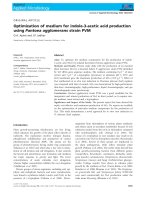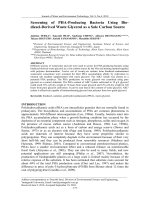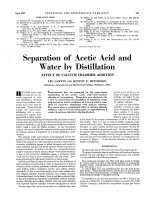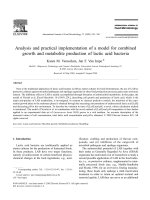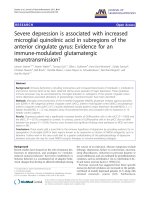Acetic Acid Bacteria - screening of LAB strains
Bạn đang xem bản rút gọn của tài liệu. Xem và tải ngay bản đầy đủ của tài liệu tại đây (41.96 KB, 7 trang )
World Applied Sciences Journal 4 (5): 741-747, 2008
ISSN 1818-4952
© IDOSI Publications, 2008
Corresponding Author: Dr. Bukola C. Adebayo-tayo, Department of Microbiology, University of Uyo. Uyo Akwa Ibom
State, Nigeria
741
Screening of Lactic Acid Bacteria Strains Isolated from
Some Nigerian Fermented Foods for EPS Production
Bukola C. Adebayo-tayo and Abiodun A. Onilude
1 2
Department of Microbiology, University of Uyo, Uyo Akwa Ibom State, Nigeria
1
Department of Botany and Microbiology, University of Ibadan, Ibadan, Oyo State Nigeria
2
Abstract: This study was embarked upon to obtain laboratory strains of lactic acid bacteria from some
traditional fermented foods, with potential for the production of exopolysaccharides (EPSs), which is an
important factor in assuring the proper consistency and texture of fermented food. One hundred and fifteen
strains of Lactic Acid Bacteria (LAB) were isolated and characterized from some fermented dairy (“Nono”,
“Fura”, Yogurt, “Wara”) and non-dairy foods (“Ogi” and “Fufu”). Lactic acid bacteria species identified were
L. fermentum, L.casei, L.plantarum, L. brevis, L.cellobiosus, L. delbrueckii, L..coryniformis, L. coprophilus,
L.gensenii, L. lechmanii and Leu paramesenteroides. 103 LAB isolates were screened for their EPS producing
activity. The investigation in the screening for EPS synthesis by LAB isolated from dairy and non dairy product
showed that more than 50% of the studied L.plantarum strains are active producers of Exopolysaccharide while
40% of the studied L.fermentum, 50% of L.delbrueckii, Leu. mesenteroides ssp dextranicum, 20% of
Leu.mesenteroides ssp mesenteroides, Leu. gelidium, 10% of L.casei, L. cellobiosus, Leu. amelbiosum, Lact.
plantarum, Lact. piscium respectively are active producer of exopolysaccharides. The L casei ssp
pseudoplantarum, L.casei ssp tolerans, Leu. mesenteroides ssp hordinae, Leu. pseudoplantarum Lact.
raffinolactis, Lact. lactis ssp cremoris manifest poor production activity while Lact. raftinolactis and
Lact.gravieae did not reveal any exopolysaccharides activity. Their EPS ranged between 01.00-196.0 mg lG
1
respectively.
Key words: Lactic acid bacteria % EPS % Identification % species % fermented foods
INTRODUCTION cholesterol-lowering activities [4]. Lactic acid bacteria are
A variety of polysaccharides produced by plants interest has been shown in their use since they could be
(cellulose, pectin and starch), algae (agar, alginates and considering “natural” products. Some LAB is capable of
carrageen an) and bacteria (alginate, dextran, gellan, producing a range of EPS. Of those, which have been
pullulan and xanthan gum) are commonly used as food investigated for EPS production, the majority has been
additives for their gelling, stabilizing or thickening isolated from dairy products [5-11]. A lot of Lactic Acid
properties [1]. However, the use of polysaccharides Bacteria (LAB) that produce exopolysaccharide (EPS) are
excreted during the manufacture of food, such as available from indigenously fermented foods but lack of
yoghurt, might be attractive for the food industry and a local central culture collection center could not bring out
should constitute a new generation of food thickeners. the quality, quantity and physiological characteristics of
To date, exopolysaccharides (EPSs) produced by Lactic such organisms or their EPS. However, information on
Acid Bacteria (LAB) have received increasing interest their biosynthesis and molecular organization and
mainly because of their GRAS (generally regarded as safe) fermentation strategy is rather scarce and the kinetics of
status [1] and their rheological (LAB) properties in food EPS formation is poorly described. Moreover, the
to improve the texture of fermented products [2]. Some production of EPS is low and often unstable and their
EPSs produced by LAB present potential health-beneficial downstream processing is difficult. This study was
properties, such as immune stimulation [3], anti-ulcer and therefore, aimed at isolation and identification of LAB
found in the range of fermented foods, therefore much
World Appl. Sci. J., 4 (5): 741-747, 2008
742
from some Nigeria fermented foods and to screen the Isolates were identified (genus and species) using the
isolate for their potential for EPS production. API 50 CH system (Bio-merieux, France). This identity kit
MATERIALS AND METHODS carbohydrate fermentation patterns is unique to each
CoIlection of samples: The lactic acid bacteria isolates
were obtained from fermented dairy products (Yoghurt, Screening of the isolates for EPS production: The
“Nunu”, “Fura” “Fura da nono” and “wara”) and non identified isolates were screened for EPS producing
dairy traditionally prepared “fufu” from cassava and “ogi” activity by propagating them in ESM (Exopolysaccharides
made from white and yellow maize (Zea mays) and red selection medium) used by van den Berg et al. [9] and
guinea corn (Sorghum bicolor) collected from various labeled mESM. This medium contained 5% skim milk,
locations in Nigeria. (Bodija market and Sabo in Ibadan, 0.35% /v yeast extract, 0.35% /v peptone and 5% /v
Oyo State, Oja Oba and Oke Ope market in Ilorin, Kwara glucose.
State, Usmadan Fodio University, Sokoto, Sokoto State, The isolates were transferred in MRS agar slants into
Ariaria main market and new market in Aba, Abia State 10 ml MRS broths and incubated for 24h at 30°C. A
and Uyo main market in Uyo, Akwa Ibom State loopful of each of these cultures was transferred into 100
respectively). Samples were taken to the laboratory for ml conical flasks containing 10ml of mESM broth and
microbiological analysis. the broths were incubated anaerobically for 24h at 30°C.
Isolation of lactic acid bacteria: Serial dilutions of flasks containing 90 ml of mESM broth and incubated at
homogenized “fufu” and “ogi”, “Fura”, “Nunu”, “Fura da 30°C for 30h.
nunu”, “Wara” and yoghurt samples in 0.1% peptone Samples were taken for analysis at the end of the
saline were used for microbial isolation on MRS agar [13] fermentation period.
respectively. Plates were incubated at 24 h at 35°C for
isolation of mesophilic LAB. Isolation methods were Measurement of growth: The optical density at 620 mm
similar to those recommended by Van den Berg et al. [9]. was used to monitor cell growth after appropriate dilution
The isolates were maintained on MRS agar plates (Oxoid of samples.
No. CM361) containing 50 mg 1G of nystatin (Sigma,
1
Australia) kept at 4°C under anaerobic conditions. Isolation, purification and quantification: The
Culture identification: Gram staining, catalase method of Garcia-Garibay and Marshall [19]. The
activity, gas production from glucose, growth in NaCl lactic acid culture was treated with 17% ( /v) of 80%
6.5% was determined according to methods for lactic trichloroacetic acid solution and centrifuged at
acid bacteria [13]. 16,000-x g at 4°Cfor 30min.The clarified supernatant was
The identification work was done according to the concentrated 5 times by evaporation using a rotavap
methods described in Bergey’s Manual [15] and the evaporator. The exopolysaccharides were precipitated by
Prokaryotes [16]. All the strains were maintained by adding 3 volumes of cold absolute ethanol and stored
weekly sub culturing from 48hrs MRS agar cultures. overnight at 4°C. Finally, the recovered precipitates were
The cultures were examined microscopically by staining redissolved with distilled water and dialyzed against the
and morphological characteristics noted. Gram staining, same solution for 24h at 4°C. To remove residual lactose
catalase activity, oxidase test Gelatin hydrolysis were from the medium. The polysaccharides were freeze-dried
done using the method of Harigon and McCance [16]. and stored at 4°C. The total amount of carbohydrates in
Growth characteristics were monitored daily at 15°C, 30 the polysaccharides was determined by the phenol-
and 45°C in tubes of MRS broth over 7days period. Salt sulfuric acid method described by Dubois et al. [20]. The
tolerance was assessed after 3days of incubation at exopolysaccharides production was expressed as mg 1G .
concentration of 40 and 65 g lG NaCl in MRS broth.
1
Production of ammonia from arginine was done according RESULT AND DISCUSSION
to the method described by AbdEL-Malek and Gibson
[17], Nitrate reduction was done as described by A total of One hundred and thirteen lactic acid
Gerhardt et al. [18]. bacteria isolates were obtained from seven fermented
works on the principle that each of the different types of
bacterium and thus differentiates between them.
w w w
The 10 ml inocula were transferred into 200 ml conical
exopolysaccharides were isolated according to the
w
1
World Appl. Sci. J., 4 (5): 741-747, 2008
743
foods (Wara’’, “nono”, “fura”, “fura da nono”, yoghurt,
“fufu” and “ogi”) in Nigeria. The isolates were initially
differentiated on the basis of their cultural and cellular
morphological studies after which they were subjected to
various physiological and biochemical tests.
The isolates were Gram positive, rods, cocci, ovoid
and produce no endospore. They showed moderate or
scanty growth on MRS agar. The isolates were oxidase,
catalase, gelatin, casein hydrolysis, Nitrate reduction,
hydrogen sulphide and Voges Proskauer negative. Some
strains hydrolysed starch and they were facultative
anaerobes and were fermentative rather than being
oxidative in nature. These were L. fermentum, L.casei,
L.plantarum, L.brevis, L.cellobiosus, L.delbrueckii,
L.coryniformis, L.coprophilus, L.jensenii, L.leichmanii
and Leu. pseudoplantarum, Lact. plantarum, Lacto.
Raffinolactis and Lact.piscium.
After the preliminary characterization test, 57 of them
were found to belong to genus Lactococcus, 28 strains
were determined to subspecies level and were identified
as L.casei ssp pseudoplantarum LCN4 and LCN5,
L.casei ssp tolerant, L.coryniformis ssp coryniformis,
L.coryniformis ssp tonquence, Leu. mesenteroides ssp
mesenteroides, Leu. mesenteroides ssp cremoris, Leu.
mesenteroides ssp dextranicum, Lact. lactis ssp cremoris,
Lact. Hordinae and Lact.lactis ssp plantarum. All the
bacteria isolated from the fermented foods fit the
classification of LAB as Gram-positive, catalase negative
and oxidase negative [21]. Classification of the isolates led
to identification of species.
The frequency of occurrence of lactic acid bacteria in
the categorized fermented dairy and non-dairy food are
shown in Table 1. The most predominant LAB species
isolated was Lactobacillus plantarum followed by Leu.
mesenteroides ssp mesenteroides. As in the earlier reports
[22] on the occurrence of lactic acid bacteria spectrum,
L. plantarum constituted the highest number of LAB
isolated from fermented plant materials. The involvement
of various types of LAB in fermented vegetables and
plant materials had earlier been reported [23-25].
Thus LAB were present in fermenting foods, because
of their ability to produce high levels of lactic acid as well
as being able to survive under high acidic conditions.
High percentage of L.plantarum recorded in this present
study could be due to the fact that majority of the
substrate used in the preparation of the fermented foods
are of plant origin.
The identification of different types of LAB species
in the present study could be due to the fact that majority
of the substrate used in the preparation of the fermented
Table 1: Species and frequency of occurrence of lactic acid bacteria isolated
from fermenteddairy and non-dairy food
Freqency of
Source Lab strains occurrence (%)
White "Ogi" Lactobacillus plantarum 30.8
Leuconostoc mesenteroides
subsp hordinae 8.0
Leuconostoc gelidium 8.0
Leuconostoc amellbiosum 8.0
Lactobacillus delbrueckii 15.4
Leuconostoc pseudomesenteroides 8.0
Lactobacillus raffinolactis 8.0
Lactobacillus helveticus 8.0
Lactobacillus cellobiosus 8.0
Yellow "Ogi" Leuconostoc pseudomesenteroides 20.0
Lactobacillus plantarum 20.0
Leuconostoc amellbiosum 20.0
Lactobacillus sp 20.0
Lactobacillus cellobiosus 20.0
Brow "Ogi" Lactobacillus lactis spp cremoris 33.3
Lactobacillus fermentum 33.3
Lactobacillus plantarum 33.3
"Nono" Lactobacillus brevis 5.3
Lactobacillus plantarum 15.8
Lactobacillus fermentum 5.3
Lactobacillus casei 5.3
Leuconostoc lactis 10.5
Lactobacillus curvatus 5.3
Lactobacillus piscium 15.8
Leuconostoc mesenteriodes
subsp mesenteroides 5.3
Lactobacillus casei
subsp pseudoplantarum 10.5
Lactobacillus casei subsp tolerans 5.3
Leuconostoc gelidium 10.5
Lactobacillius fructovoran 5.3
Fura Lactobacillius coprophilus 14.3
Leuconostoc amellbiosum 28.5
Lactococcus hordniae 14.3
Lactobacillius helveticus 14.3
Lactobacillius plantarum 14.3
Leuconostoc mesenteroides
subsp cremoris 14.3
"Fura da Nono" Lactobacillius plantarum 25.0
Leuconostoc mesenteroides
subsp dextranicum 25.0
Leuconostoc mesenteroides
subsp cremoris 25.00
Lactobacillius plantarum 25.00
World Appl. Sci. J., 4 (5): 741-747, 2008
744
Table 1: Continued
"Wara" Lactococcus garvieae 6.25
Lactococcus raffinolactis 6.25
Leuconostoc mesenteroides
subsp mesenteroides 6.25
Leuconostoc mesenteroides 6.25
Leuconostoc gelidium 12.50
Lactococcus lactis subsp cremoris 6.25
Leuconostoc pseudomesenteroides 6.25
Lactobacillus coryniformis
subsp coryniformis 6.25 One hundred and three isolates were screened for
Lactobacillus cellobiosus 6.25
Lactobacillus plantarum 6.25
Lactobacillus casei 6.25
Lactococcus hordniae 6.25
Leuconostoc amellbiosum 6.25
Lactococcus lactis ssp hordniae 6.25
Lactococcus mesenteroides ssp. cremoris 6.25
Choice Milk Lactobacillus sp 20.00
Yogurt Lactobacillus brevis 20.00
Lactobacillus sp 20.00
Lactobacillus lactis subsp cremoris 20.00
Lactobacillus desidiosus 20.00 of Exopolysaccharide while 42.85% of the studied
Topson Yogurt Leuconostoc mesenteroides L. fermentum, 50% of L.delbrueckii, Leu. mesenteroides,
subsp mesenteroides 16.7
Lactobacillus sp 16.7
Lactobacillus jensenii 16.7
Lactobacillus coryniformis
subsp torquens 16.7
Leuconostoc mesenteroides
subsp mesenteroides 16.7
Leuconostoc mesenteroides
ssp dextranicum 16.7
Peak Yogurt Lactobacillus vinduscens 25.0
Lactobacillus leichmanii 25.0
Lactobacillus plantarum 25.0 not reveal any exopolysaccharides activity. These results
Lactobacillus lactis subsp plantrum 25.0
Sunmilk Lactobacillus salvarius 66.7
Yogurt Lactobacillus lactis subsp plantrum 33.3
Garden city Leuconostoc lactis 25.0
Yogurt Lactobacillus fermentum 25.0
Lactobacillus plantarum 25.0
Lactobacillus lactis ssp plantarum 25.0
Fanmilk Lactobacillus fermentum 25.0
Yogurt Lactococcus mesenteroides 25.0
Leuconostoc amellbiosum 25.0
Lactococcus
mesenteroides ssp. mesenteroides 25.0
"Fufu" Lactobacillus plantarum 64.3
Lactobacillus casei ssp tolerans 7.1
Lactobacillus casei 7.1
Lactobacillus hilgardii 7.1
Lactobacillus cellobiosus 7.1
Lactobacillus fermentum 7.1
foods are of different plant and animal origins and each
particular plant species provides a unique environment in
terms of completing micro-organisms natural plant
antagonists, type availability and concentration of
substrate and various physical factors. These conditions
allow for the development of epiphytic flora, from which
arises a population and sequence of fermentation
microorganisms when the plant materials harvested and
prepared for fermentation.
EPS producing activity. 191 isolates from the selected
food samples showed EPS production; only two isolates
did not produce EPS (Table 2). This was in contrast to
studies reported by Van den Berg et al. [9]. In which only
30 strains out of 607 tested showed the ability to produce
exopolysacchrides.
The investigation in the first stage of screening
for EPS synthesis by LAB isolated from dairy and
non dairy product showed that more than 64.29% of
the studied L. plantarum strains are active producers
L. casei ssp pseudoplantarum and L. lactis, 100% of
L. casei ssp tolerans, L. brevis, L. coryniformis, Leu.
mesenteroides ssp dextranicum and L. ssp, 40% of Leu.
gelidium, L. cellobiosus, 66.7% of Lact. lactis ssp
plantarum and 2.57% of Leu. amellbiosum respectively
are active (EPS above 40 mg lG ) producer of
1
exopolysaccharides, As shown in Table 2. The Lact.
lactis ssp cremoris, Lact. gravieae and Lact. plantarum
manifest poor (below 40 mg lG ) production activity while
1
Lact. raftinolactis (ORWI) and Lact.gravieae(OGW2) did
agreed with results about EPS from LAB produced by
other authors [4].
The EPS ranged between 0.10-185.2 mg lG .
1
L.plantarum (LPWO11) strains isolated from white “ogi”
had the highest while the strain isolated from “brown ogi”
(LPBOI4) had the lowest EPS activity. Among the
L. fermentum strains the EPS ranged between 5.3-141.5
mg lG . L. fermentum (LFFN3) isolated from yoghurt had
1
the highest while the strain isolated from” Brown ogi”
(LFY4) had the least.
Among the L.casei strains, the EPS ranged between
6.4-138.8 mg lG in which L.casei ssp tolerans (LCN6)
1
isolated from “fufu” had the highest and L.casei (LCW2)
isolated from “brown ogi” had the least. Two strains of
L.brevis isolated from “nono” and yogurt produced
reasonable quality of EPS. Among the L.cellobiosus
strains the EPS ranges between 14.9-74.0 mg lG in which
1
World Appl. Sci. J., 4 (5): 741-747, 2008
745
Table 2: Production of exopolysaccharides by lactic acid bacteria isolate Table 2: Continued
Exopolysa 42 L.fructvorans FW 29.0 "Wara" 0.0
-ccarides Occurrence 43 L.helveticus HF1 50.1 "Fura" 50.0
Lactic acid bacteria (Mg lG ) Sources (%) 44 L.helveticus hN2 12.7 "Nono" 50.0
1
Screening of Lab for Eps production
1 L.plantarum LPN1 170.0 "Nono" 64.29
2 L.plantarum LPN2 17.0 "Nono" 64.29
3 L.plantarum LPFN3 144.9 "Furada nono" 64.29
4 L.plantarum LPW4 17.2 "Wara" 64.29
5 L.plantarum LPF5 62.2 "Fura" 64.29
6 L.plantarum LPN6 115.8 "Nono" 64.29
7 L.plantarum LPW7 5.0 "Wara" 64.29
8 L.plantarum LPY8 164.4 Yogurt 64.29
9 L.plantarum LPY9 98.0 Yogurt 64.29
10 L.plantarum LPW010 79.4 White "ogi" 64.29
11 L.plantarum LPW011 185.2 White "ogi" 64.29
12 L.plantarum LPW012 5.8 White "ogi" 64.29
13 L.plantarum LPY013 62.2 Yellow "ogi" 64.29
14 L.plantarum LPB014 1.0 Brown "ogi" 64.29
15 L. fermentum LFNI 17.0 "Fura da nono" 42.85
16 L. fermentum LFN3 86.9 Yogurt 42.85
17 L. fermentum LFFN3 41.0 Yogurt 42.85
18 L. fermentum LFY4 141.5 Yogurt 42.85
19 L. fermentum LFY5 05.3 Brown "ogi" 42.85
20 L. fermentum LFB06 175.0 Yogurt 42.85
21 L. fermentum LFY7 54.3 Fufu 42.85
22 L. casei LCFU 148.2 "Nono" 50.0
23 L. casei LCN1 55.5 "Wara" 50.0
24 L. casei LCW2 64.0 "Brown ogi" 50.0
25 L. casei LCN3 62.2 "Nono" 50.0
26 L. casei ssp
pseudoplantarum LCN4 1.0 "Nono" 50.0
27 L. casei ssp
pseudoplantarum LCN5 43.4 "Nono" 50.0
28 L. casei ssp
tolerans LCN6 138.8 Fufu 50.0
29 L. casei ssp
tolerans LCF7 43.4 Fufu 50.0
30 L. brevis LBN1 197.4 "Nono" 100.0
31 L. brevis LBY2 80.0 "Yogurt" 100.0
32 L. cellobiosus LCEWI 74.0 "Wara" 40.0
33 L. cellobiosus LCEW2 14.9 "Wara" 40.0
34 L. cellobiosus LCE03 17.3 "Ogi" 40.0
35 L. cellobiosus LCEY04 22.3 Yellow "ogi' 40.0
36 L. cellobiosus LCEW5 40.5 "Wara" 40.0
37 L.delbrueckii LD01 116.4 "ogi" 500.0
38 L.delbrueckii LD02 2.5 "ogi" 50.0
39 L.coprohilus COFNI 64.7 "Fura da nono" 100.0
40 L. coryniformis ssp
coryniformis LCOW1 68.2 "Wara" 50.0
41 L.coryniformis ssp
torquens CYY2 138.0 Yogurt 50.0
45 L.curvatus CY1 36.6 Yogurt 0.0
46 L.decidious DY1 174.0 Yogurt 100.0
47 L.jensenii JY1 138.0 Yogurt 100.0
48 L. vinducens VTI 137.9 Yogurt 100.0
49 L.leichmanii LY1 123.5 Yogurt 100.0
50 L.salvarius SY1 167.9 Yogurt 100.0
51 L.higardi. LHFU 196.0 Fufu 100.0
52 Leu. mesenteroides
UMN1 33.0 "Nono" 50.0
53 Leu. mesenteroides ssp
mesenteroides UMM2 83.8 Yogurt 50.0
54 Leu. mesenteroides ssp
mesenteroides UMMY3 35.9 Yogurt 50.0
55 Leu. mesenteroides ssp
mesenteroides UMMY4 86.9 Yogurt 50.0
56 Leu. mesenteroides ssp
mesenteroides UMMY5 118.2 Yogurt 50.0
57 Leu. mesenteroides ssp
mesenteroides UMMW6 35.9 "Wara" 50.0
58 Leu. mesenteroides ssp
mesenteroides UMMN7 47.8 "Nono" 50.0
59 Leu. mesenteroides ssp
mesenteroides UMMW8 48.7 "Wara" 50.0
60 Leu. mesenteroides ssp
mesenteroides UMMW9 32.8 "Wara" 50.0
61 Leu. mesenteroides ssp
mesenteroides UMMN10 3.1 "Wara" 50.0
62 Leu. mesenteroides ssp
hordinae UMMHW10 3.1 White"Ogi" 0.0
63 Leu. mesenteroides ssp
hordinae UMMHW011 26.1 White"Ogi" 0.0
64 Leu. mesenteroides ssp
dextranicum UMMDFN12 138.0 "Fura da nono" 100.0
65 Leu. mesenteroides ssp
dextranicum UMMDFN13 138.0 "Fura da nono" 100.0
66 Leu. mesenteroides ssp
cremoris UMMC FN14 16.3 "Fura da nono" 0.0
67 Leu. mesenteroides ssp
cremoris UMMC FN15 18.3 "Fura da nono" 0.0
68 Leu. gelidium UGW1 26.5 "Wara" 40.0
69 Leu. gelidium UGFN2 26.8 "Fura da nono" 40.0
70 Leu. gelidium UGFN3 50.2 "Fura da nono" 40.0
71 Leu. gelidium UGW4 74.0 "Wara" 40.0
72 Leu. gelidium UGW05 6.6 White "ogi" 40.0
73 Leu.pseudoplantarum
UPW1 35.2 "Wara" 33.0
74 Leu.pseudoplantarum UP02 13.7 "ogi" 33.0
75 Leu.pseudoplantarumUPYO 11.3 Brown "Ogi" 33.0



